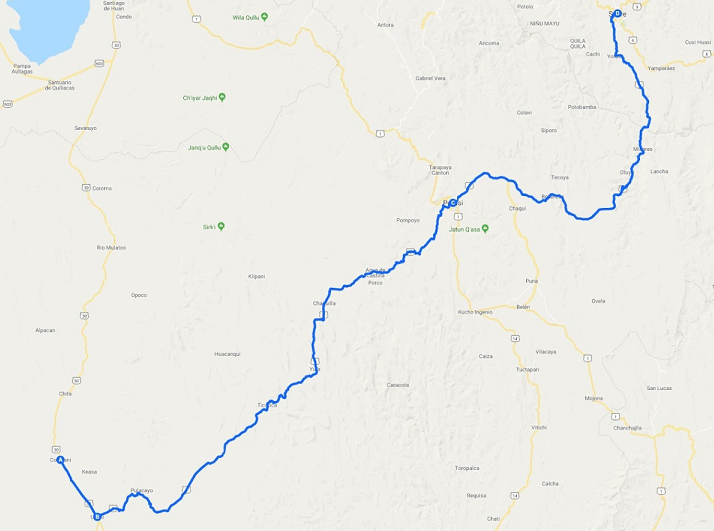
Text: Peter Johansson
Editing: Christer Lundstedt
Photos: Christer Lundstedt, Peter Johansson, Kyrie Wai
Videos: Christer Lundstedt

Tuesday 9th of July
08.28 Yet another breakfast is consumed. We have learned the routines, so everything ran smoothly.
08.51 Different things take place here at KW Hotel in Uyuni, Bolivia. A man in another room was just heard coughing, I have sneezed and it is minus degrees outside. It is rarely that we experience minus degrees in the summer trips but we are at 3700 meters above sea level and it is winter here, in other words not quite unexpected. Tomorrow morning, we're going off to the bus even earlier than now. I think it'll be anything but warm.
09.26 The time has come to bodily prepare us for today's upcoming adventure out in the salt desert Salar de Uyuni. Remove what may not be removed when, where and anyway.
09.42 Sunscreen has been applied to suitable body parts and sunglasses/clips are packed. Soon we will be ready to travel towards a much whiter world. First, we'll walk into the centre to find the vehicle we're going with today.
10.22 Here we are now waiting outside the Andes Salt Expeditions (https://www.andes-salt-uyuni.com.bo) office. We will wait for the car and the guide that has our names on a list. There are many people in motion and many different offices for various companies that all arrange excursions of different length out to the Salar de Uyuni. Next to us, we have a German family going away for days. They've bought a whole pallet of water bottles from a kiosk nearby.
10.47 Our time has come. Today's tour is about to begin. It will however be with the company Perla de Bolivia (https://perladebolivia.com). The company that we were booked with did not fill a car with tourists who wanted English guide so we were transferred here. The organizers cooperate and move people between themselves a little as it suits. With us in the car are Frida and Oscar, mother and son from Germany, Sophie from France and Kyrie from Hong Kong. We also have a guide, a woman from Bolivia who speaks excellent English.
13.48 Our lunch is over. Fortunately, we have some vegetarians with us today, in other words, more meat for the rest of us. Our hostess, guide, has taken pictures of our company in various odd situations out on the salt plains. The one-handed landscape causes everything to flow together. It's like a special depth in the pictures. We've jumped, sat in a banana boat, been inside a lunch box and were hunted by dinosaurs. We have pictures of everything.
16.50 After resting a little down by the car parking lot, we are now going to leave the island. This was an experience. The view here is phenomenal and nature with all the great cactuses was really special. This day was really worth every dollar we've paid for it.
19.30 We have said thank you and good bye to the tour driver, the guide and the three remaining in the group, Frida, Oscar and Sophie. We were released centrally in the town of Uyuni. Now Christer and I are back at the café The Guardian for a lighter dinner (burgers). We are pretty tired after all the experiences and won't look for a new restaurant for tonight's meal.
Wednesday 10th of July
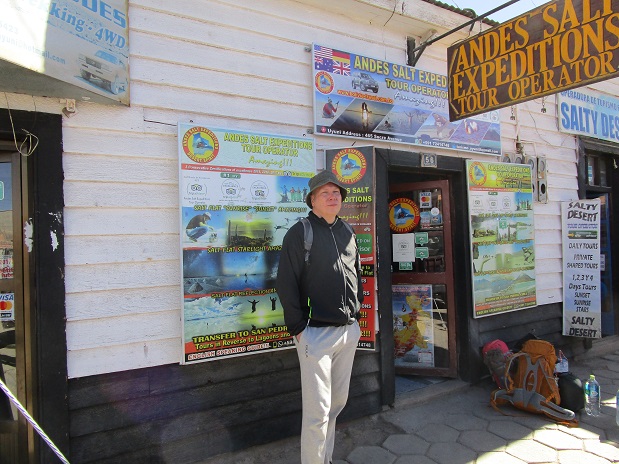
Christer is waiting for today´s tour to start.
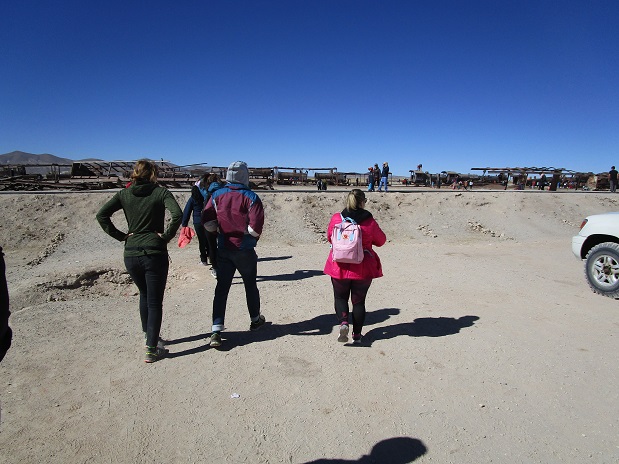
Our small group is heading for the first attraction.
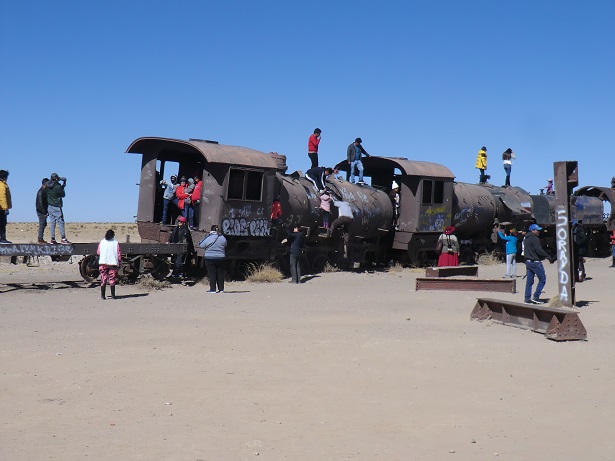
The train cemetery outside Uyuni.
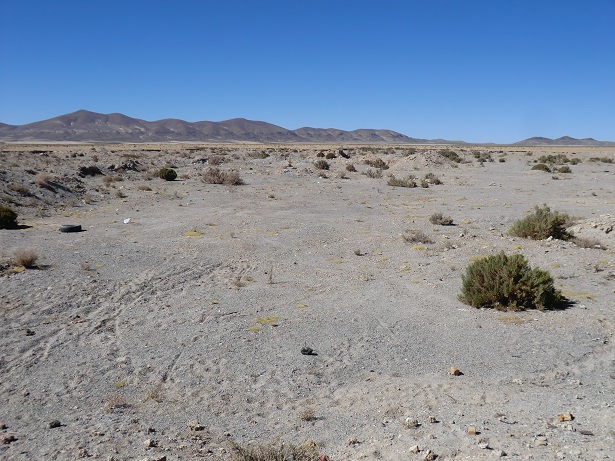
An ordinary desert. We are soon going to a salt desert.
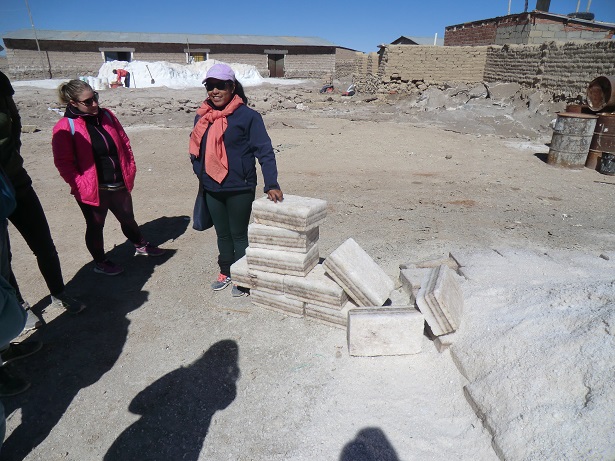
Salt lecture in Colchani.
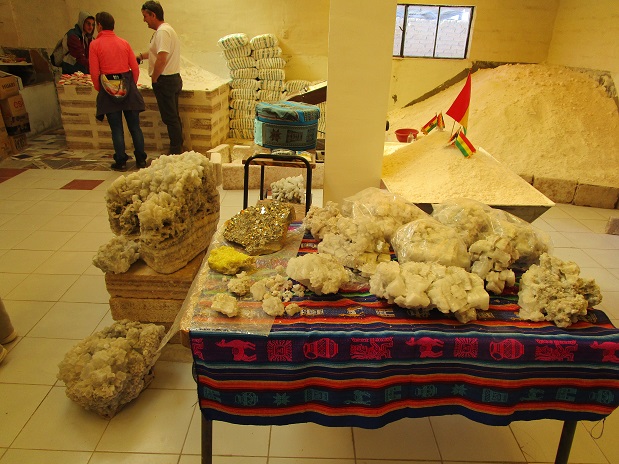
Different salt objects on display.
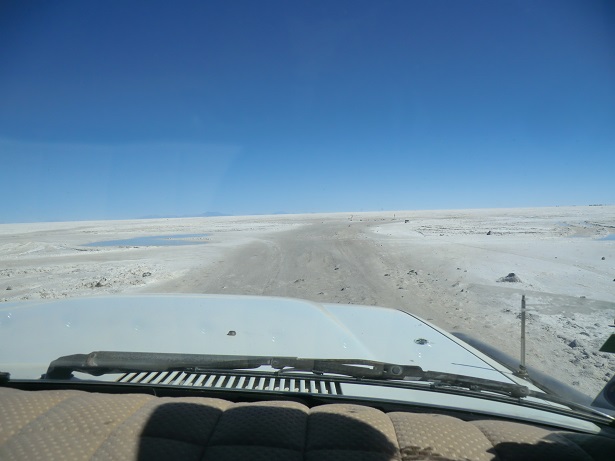
We are heading into Salar de Uyuni.
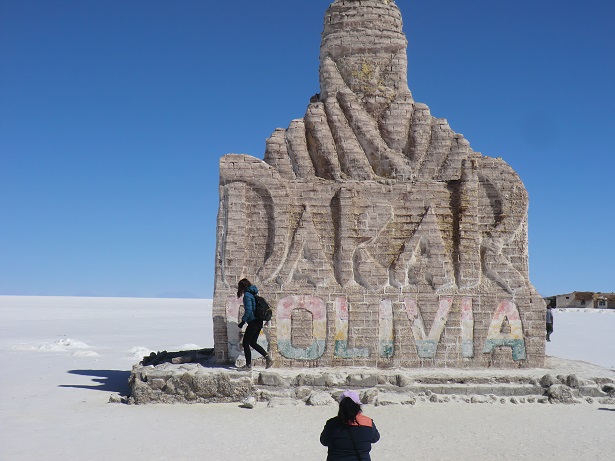
The Dakar rally monument in Salar de Uyuni.
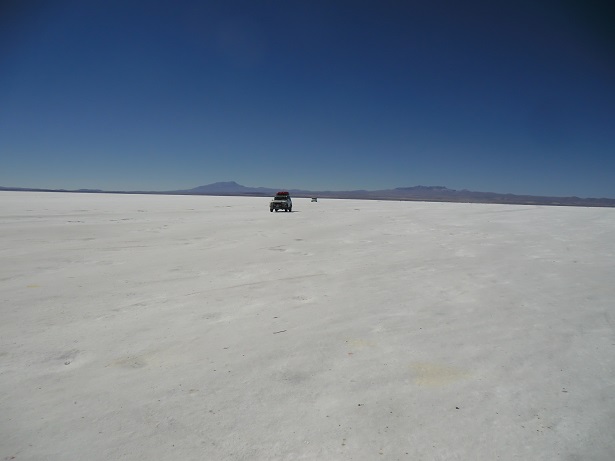
We are out in the big white.
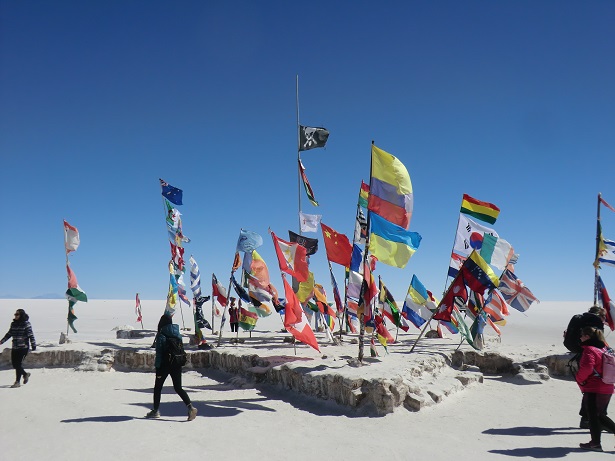
The wind hits the flags outside Hotel Playa Blanca.
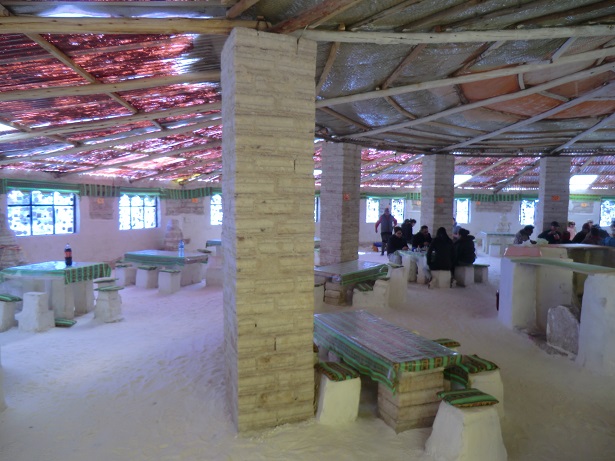
Inside the salt hotel Playa Blanca.
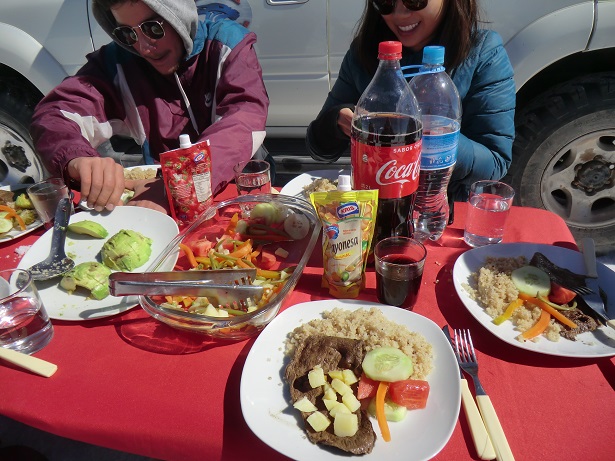
Lunch is served outdoors today.
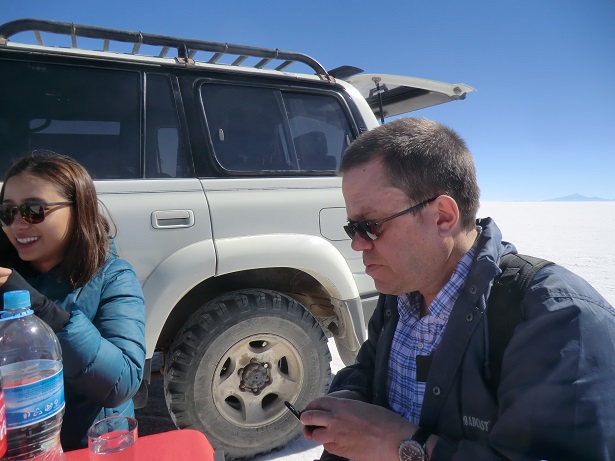
In Salar de Uyuni you have to protect your eyes.
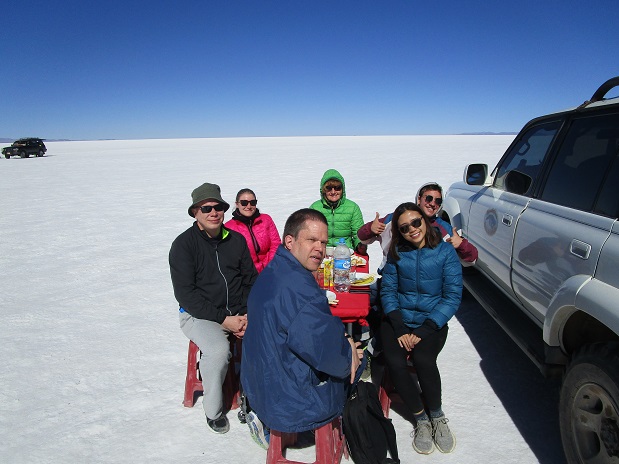
Our tour group is having lunch.
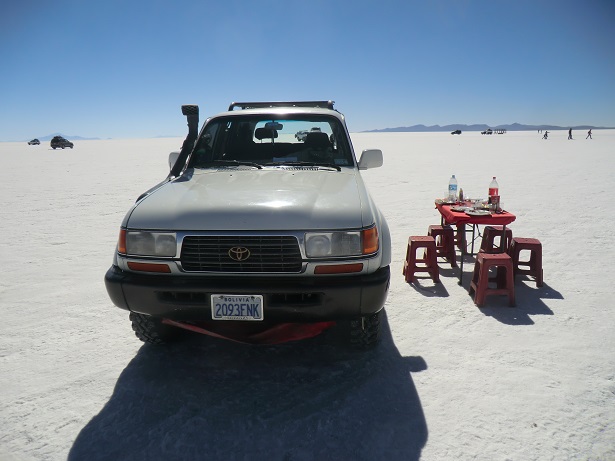
The lunch is finished.
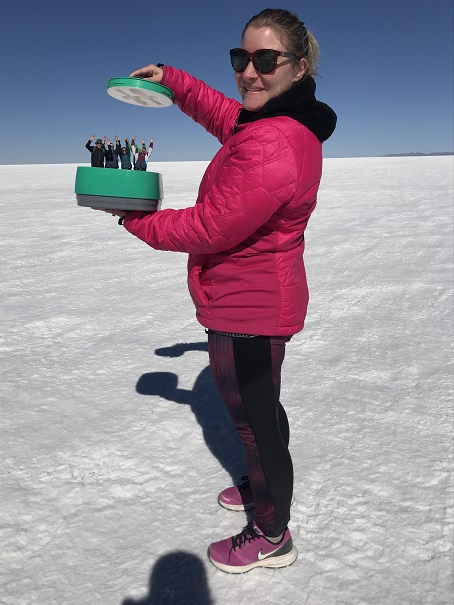
We are inside the lunch box.
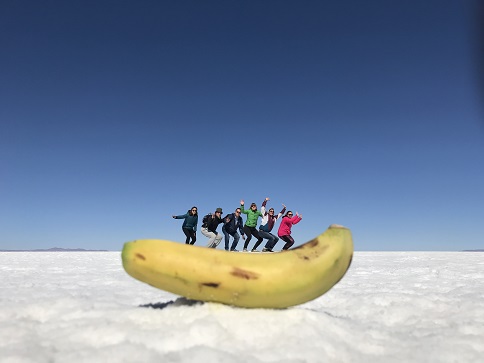
A trip with the banana boat.
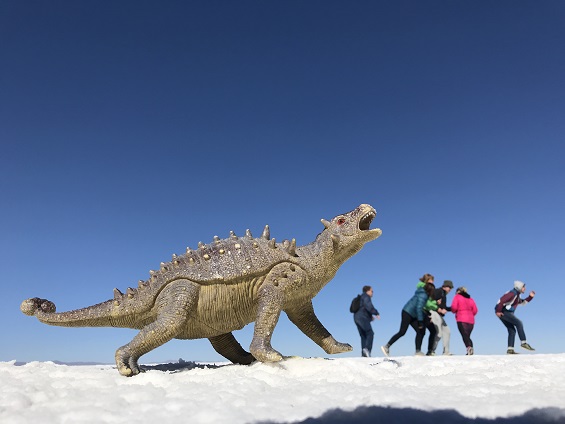
A dinosaur is chasing us.
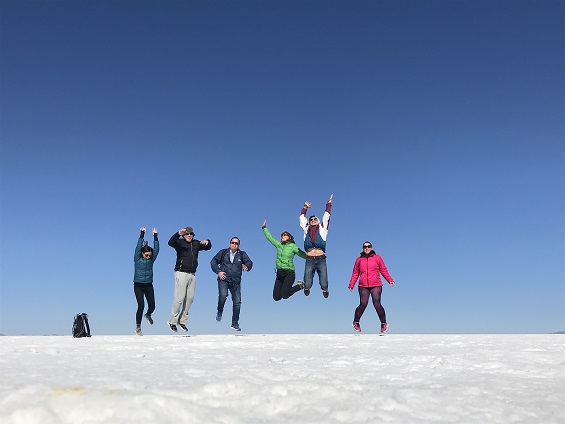
Time to jump!
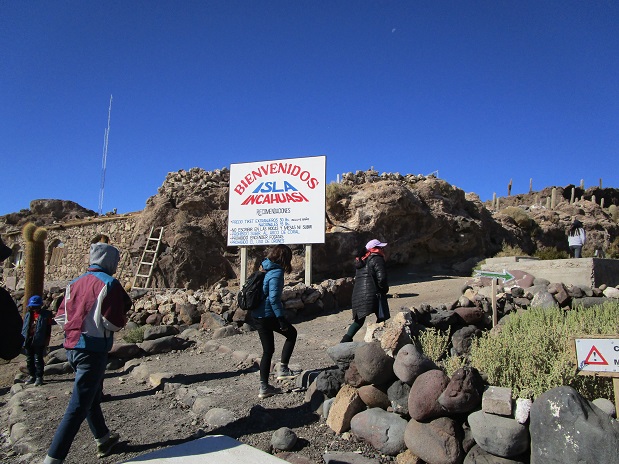
We are arriving to Incahuasi.
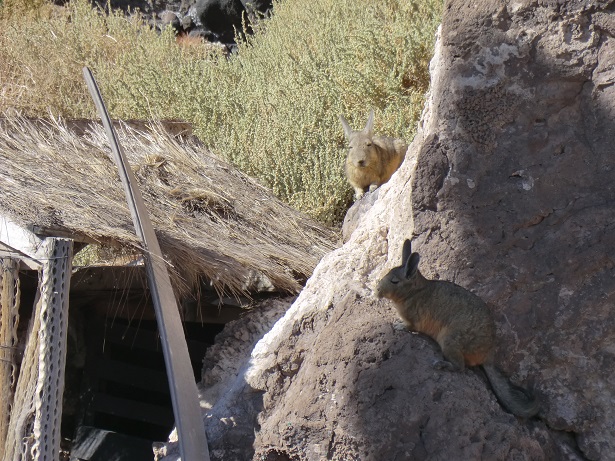
On Isla Incahuasi you can see these animals. Viscacha is the name.
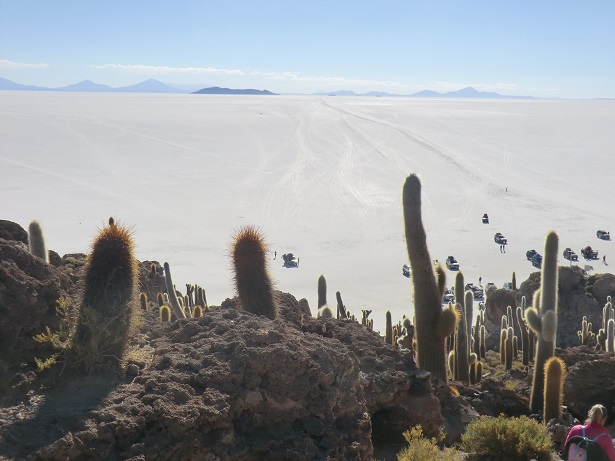
A view from Isla Incahuasi.
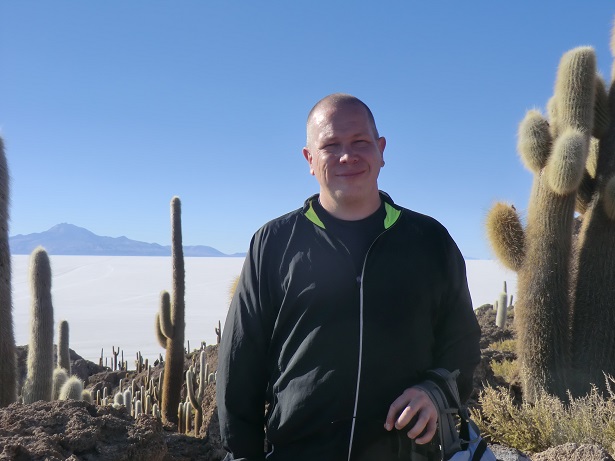
Christer among the huge cactuses.
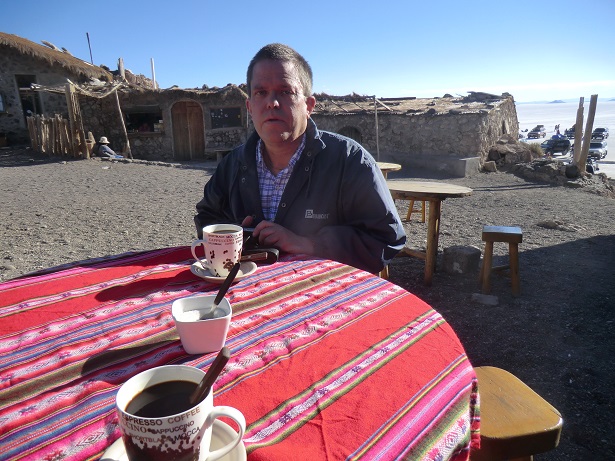
After a tiring walk it is nice with coffee.
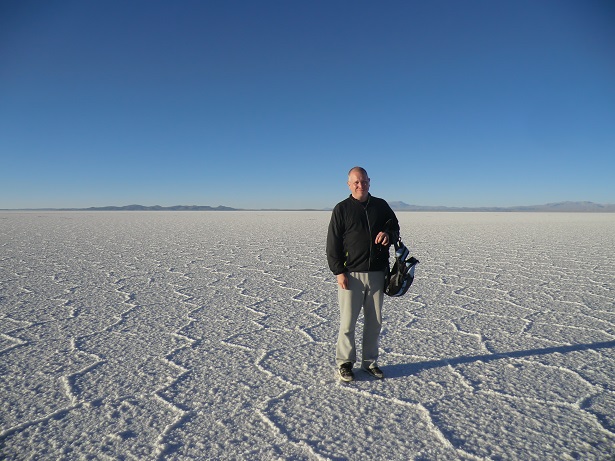
Christer in the middle of the beautiful salt landscape.
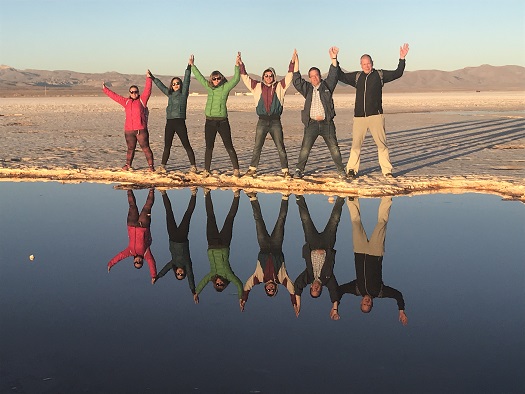
A mirror photo just before sunset.
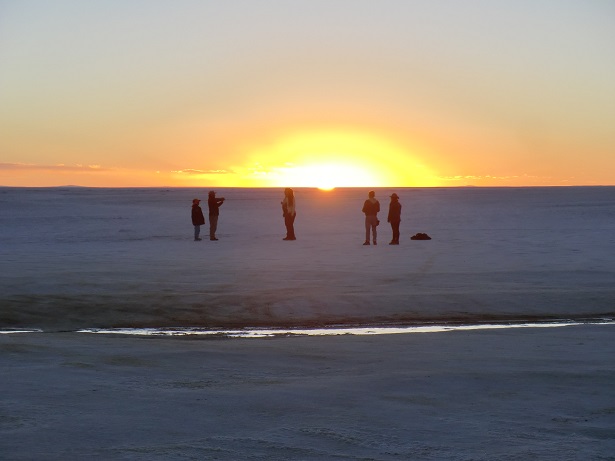
The sun is hiding and the cold temperatures arrive.
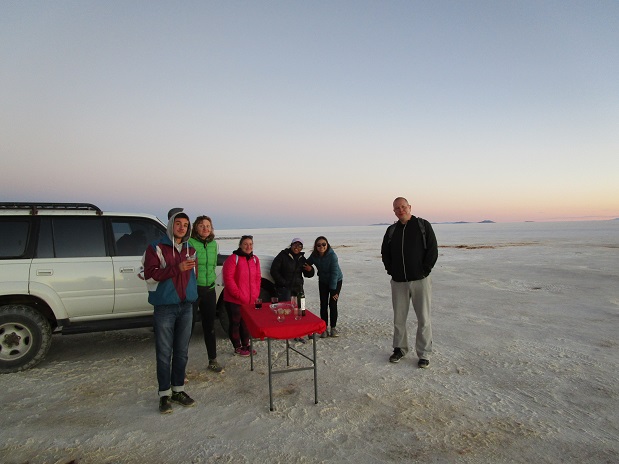
A wonderful day ends with some wine.
06.30 It is an early, chilly morning here in Uyuni, - 5C. We will, in this morning and temperature, soon walk towards the bus. This early departure is because we are only staying for one night in the next city and we therefore do not want to arrive so late that we will not see anything in there.
07.03 Our belongings are soon packed together and we are ready for our minor walk to the square where the buses arrive and depart. 07.27 It wasn't as cold as we feared. It went pretty well to stroll through the city. We are, unlike the bus, in place and ready to travel. It's a bit cold to stand still here. I hope we'll get on board soon. 07.42 It's actually colder inside the bus than outside. Stepping into it to get warm was certainly a wrong choice. The bus is in a way ahead of time or rather the bus company. It is called 11 de Julio. Today we are going even higher up. From 3700 meters above sea level, it carries on upwards. 08.16 The journey to the old colonial mining city of Potosí has begun. The bus is well roughly filled to half. 08.46 Here and there among the barren rocks is a small splash of green. It's from grass and twigs. We are still high up and most of it is dry. We have seen a vast view of the Uyuni and salt plain beyond the city. That view will be a fine memory of the stay here. 09.31 The landscape remains barren and hilly. It is a little cold in the bus but the sun warms us all the more.
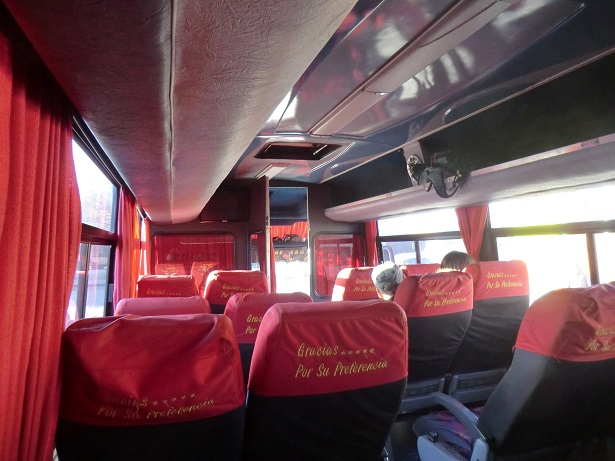
We are inside the cold bus.
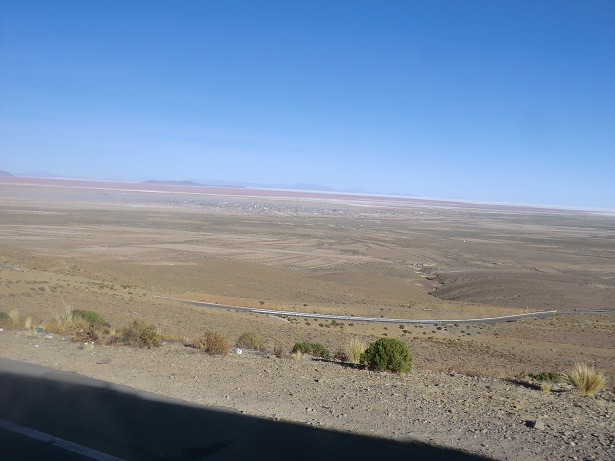
We are looking at Uyuni one last time.
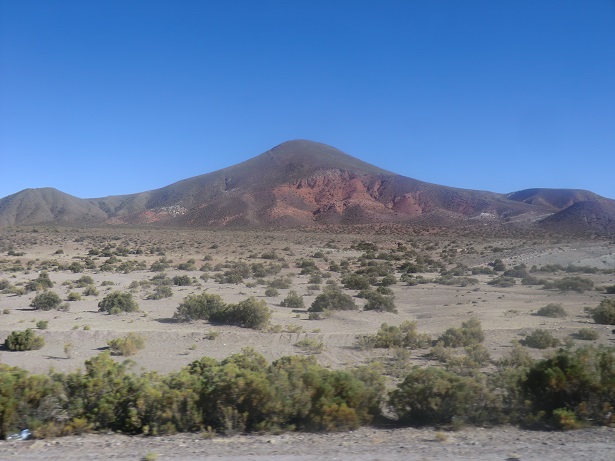
Mountains and dry landscapes along the road.
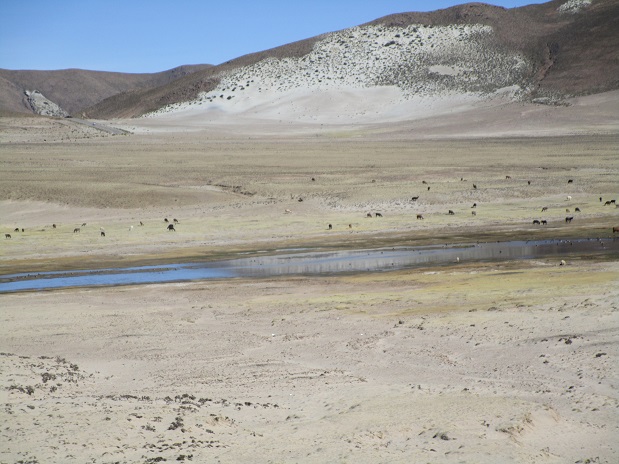
Animals have found water near Chaquilla.
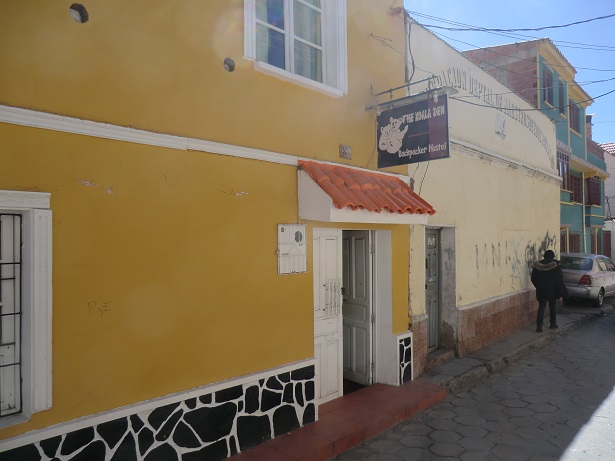
The Koala Den is our new home.
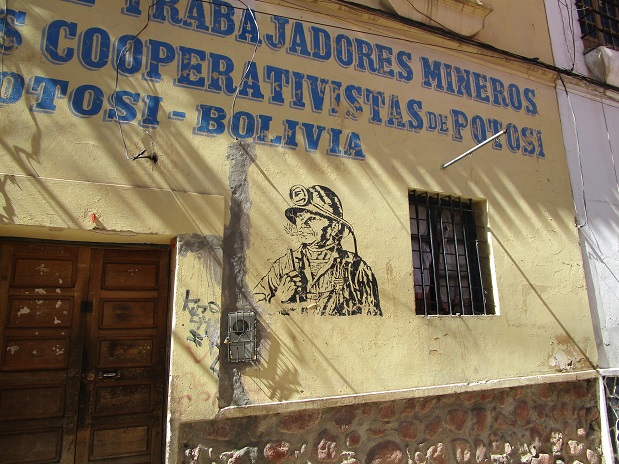
Miners as a wall painting in Potosí.
09.54 A small stream glistens beautifully alongside the route. Here and there are different types of grazing animals. There are great expanses and beautiful views during today's journey.
11.08 The bus has stopped in the middle of the dry landscape to pick up passengers. We have seen large groups or flocks of llamas. These animals are common out here in sparsely populated areas. 11.53 Our route continues up and up. How high are we right now? 12.11 We have begun to approach the mining city of Potosí. Here people have looked for silver for hundreds of years. On the way into the city we saw traces of mining operations on the mountain sides around the city. Cerro Rico (Rich Mountain) is the name of the place of the deposits. 12.30 Finally we arrived at the old bus terminal in Potosí where the buses from Uyuni arrive, now towards the accommodation! 12.50 Our taxi driver, actually this trip's first hired, took us smoothly to the hostel The Koala Den. In the centre there was full speed ahead with various parades and brass orchestras as so often in South American cities. Here at the property we have only left the bags, check-in takes place later today. 13.10 With small, easy steps we have searched and even found a lunch restaurant. We are on a parallel street to the one where The Koala Den is and soon there will be llama lunch here at Phisqa Warmis. 15.01 Good food (llama sausages with mashed potatoes) and a cup of coffee have done the trick. Additionally we have a room that is not cold, ever so great. We've never stayed this high above sea level before, 4090 meters. Now here's to gather power for a while. 16.14. I don't know if we've gathered the power we need. But if we wait longer, the sun will go down and we will miss the views here in the city.
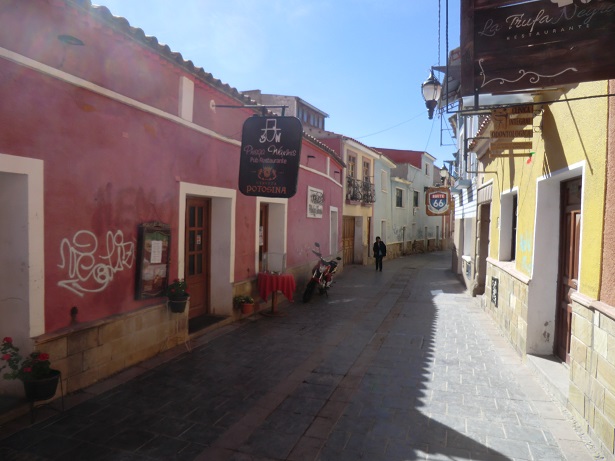
We looked for a lunch restaurant and found the nice Phisqa Warmis.
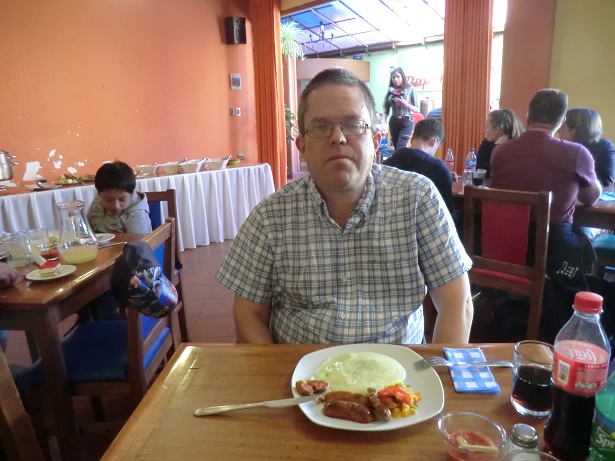
Peter is trying llama chorizo.
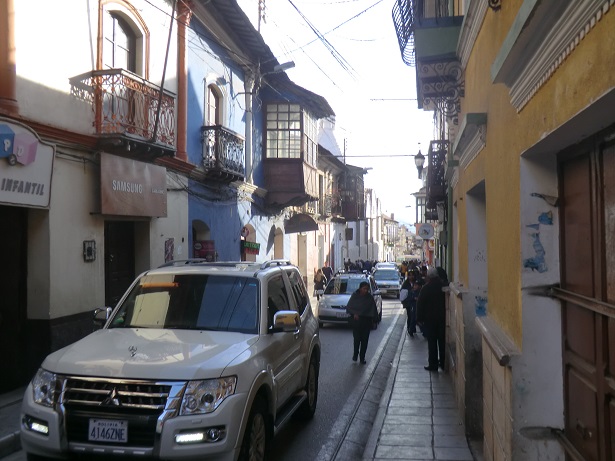
Narrow streets in Potosí.
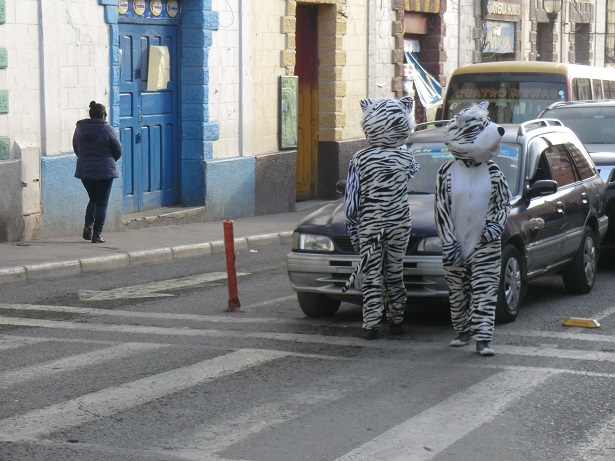
Strange looking characters are directing traffic.
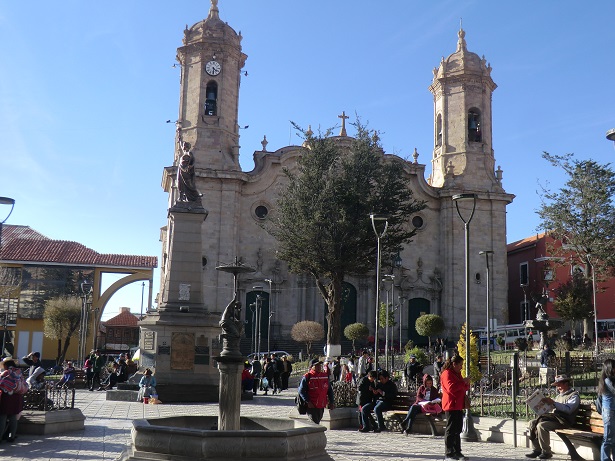
Catedral Metropolitana in the heart of the city.
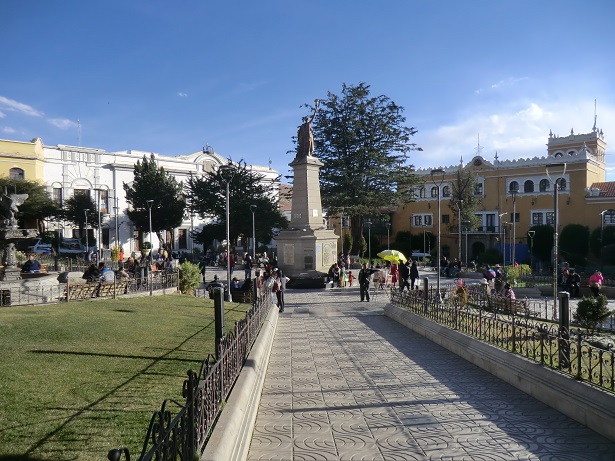
Plaza 10 de Noviembre, Potosí.
16.37 There have been some surprises after we left the room. In a sofa in the lobby was Sophie, the French girl who was on the tour yesterday. We talked to her briefly. In the city, we've seen people in zebra patterned costumes that monitor pedestrian crossings. Photos have been taken, including at the cathedral at the main square Plaza 10 de Noviembre. We are at high altitude, the streets are crowded, the sidewalks narrow and both squares in the centre lean. It is not easy to stroll around Potosí.
17.04 There is just a little power in the bodies and only some oxygen in the air. This has made us to make a stop. It will be crepes and coffe/coca tea at Café de La Plata at 10 de Noviembre square. I drink coffee and eat crepes. Christer who feels really out of order is testing with coca tea to help with the feeling of high altitude. 17.51 It was good drinks and crepes. Now we will mostly gather our energy. It sure is exhausting at this altitude. 19.37 The altitude, yesterday's adventure, the trip or whatever it may be is warring on us. We lack stamina and energy. Christer is not at all in shape, possibly has some fever too. He's mostly resting right now. 20.56 It will be a safe card for dinner. We've returned to the lunch restaurant, Phisqa Warmis. Christer does not have much appetite but will try to get in himself some kind of nutrition after all. 21.55 The tired gentlemen have returned home. On the way home, we saw two gentlemen fighting with a third man. They chased each other along the street, fists, punches and harsh words were distributed and exchanged between the combatants. How it ended, we don't know. We went home.
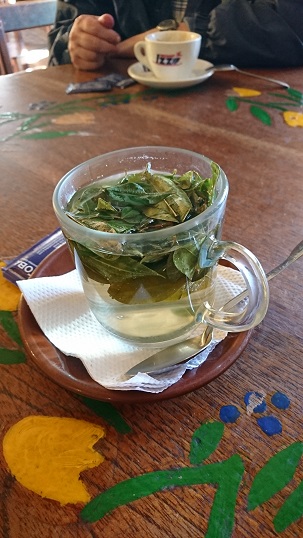
Coca tea can be useful on high altitude.
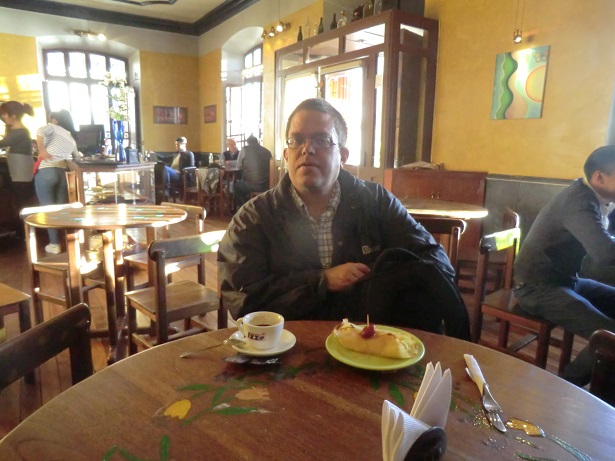
Peter is visiting the nice Café De La Plata.
08.17 Something has got us both out of order. Is it the altitude or something else? Christer is feeling the worst. He appears to have received the classic one-day virus that knocked him out in both Peru and Kenya. Alternatively, it is some kind of food poisoning that destroyed his night.
09.28 It was a smooth breakfast here at the Koala Den. It was just to sit down at a long wooden table and be served. First we were called boys at the drinks orders and when breakfast came we were suddenly children, all according to the older woman who served us. A man at the breakfast table took eight teaspoons of sugar in his tea. Sophie from France sat at our table. Now we will rest for a while. Christer ate some bananas and slowly gets his power back. 10.37 Most things now done. Today we aim for a minimal effort of the bodies. There will be taxi to and from the accommodations, both here from The Koala Den and upon arrival to Sucre later today. 10.52 The man who loves sugar seems to be an odd figure. He walks around here on the property and looks generally lost. Looks like he wants to get in touch with people, but he seems to be hesitating. He's spent the morning shaving and mirroring himself. 11.11 Some persons dressed in uniforms had priority upon our payment. They felt like some kind of controllers. They were supposed to inspect something in this building. A taxi has been called for us. A cat is strolling past us right now. 11.35 The taxi arrived, picked us up and has just dropped us off at the relatively newly built bus station Nueva Terminal de Buses here in Potosí. We're in the north of the city. 11.56 The bus terminal is very spacious and fresh. A lot of things can be found here. Upstairs was the office of our bus company, Trans Emperador. Now we have collected the pre-paid ticket and one of the dogs here has traditionally greeted us.
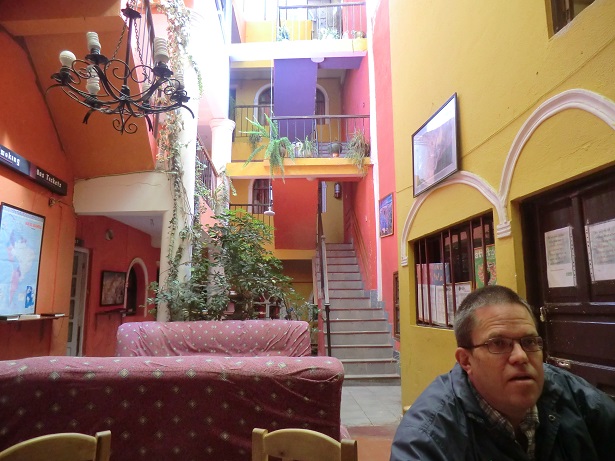
Peter inside the colourful Koala Den.
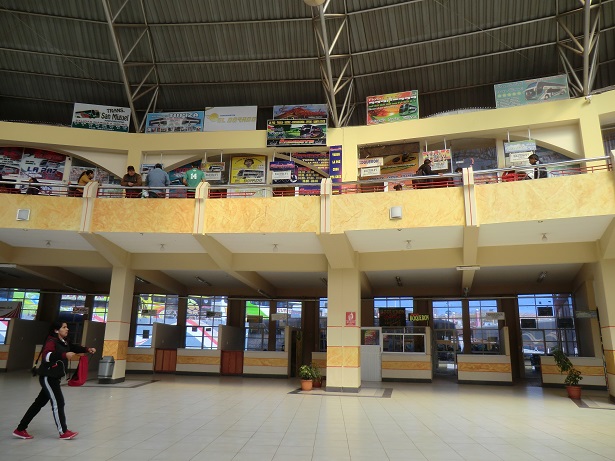
Nueva Terminal de Buses, Potosí.
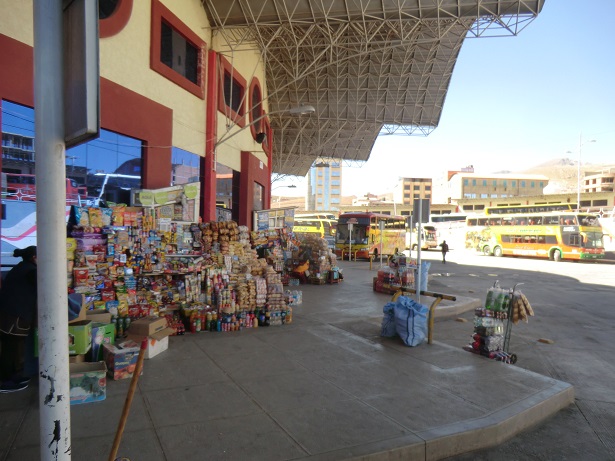
Lots of snacks to choose from ahead of the trip.
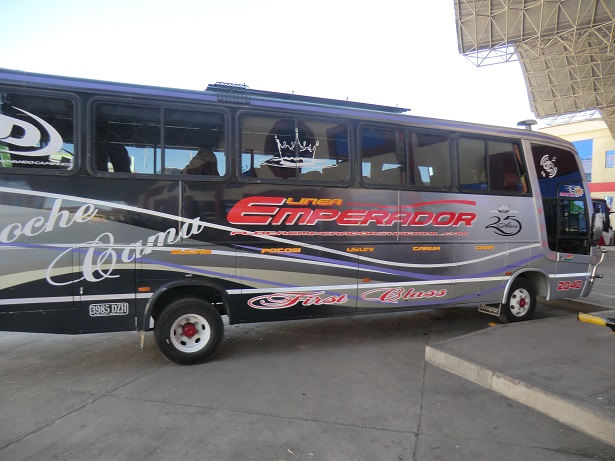
Our bus has very small wheels.
12.20 We found the right gate out of the bus terminal and have paid the usual terminal fee that one usually needs to pay here in Bolivia. Wouldn't it be easier to include it in the ticket price? Lots of drinks and snacks are sold out on the platform. Here no one needs departing thirsty or hungry.
12.41 The bus from the company Trans Emperador has now begun its and our journey to Sucre, one of Bolivia's capitals. It is slowly getting out of the city. It stops here and there. Now we are finally moving towards lower altitude above sea level. It's been a while since we were on a low level. 14.01 We are around halfway on the journey towards Sucre. On the left it is a beautiful valley with round mountain sides. It is difficult to explain in words or with a picture. It's getting greener now that we reach lower altitude. 15.55 We have been driving around for a while in Sucre and seen some different neighbourhoods. We can conclude that it is a hilly city. We just passed major sports facility, Estadio Olímpico Patria. We have now, after getting into the crowded bus station, changed our matter of transport. We're going with a taxi through the crowds of one of Bolivia's Capitals, Sucre. It is the historical and constitutional capital of the country but was lost with the capital title to La Paz in 1898 when it suffered economic decline. The city has received its name from revolutionary leader Antonio José de Sucre. 16.43 There were no problems in getting to the hotel, Capital Plaza. Our taxi driver was talkative and asked about where we have been and about upcoming travel plans. Once here at the hotel it was harder to find the room, 102. It was even harder to find the light switch. However, we have a large lovely room and outside the door there is the hotel's beautiful courtyard with seating.
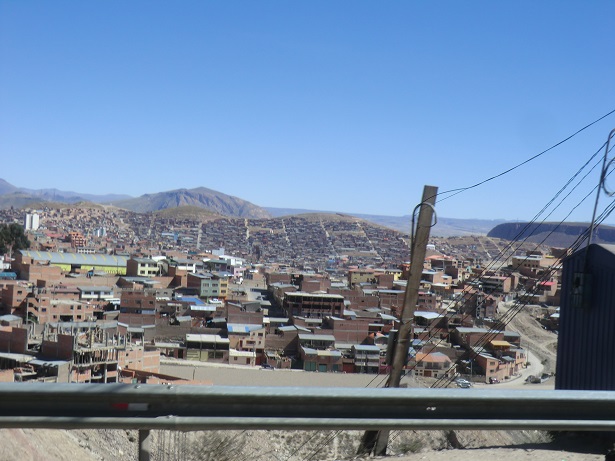
We have a nice view of Potosí when departing from the city.
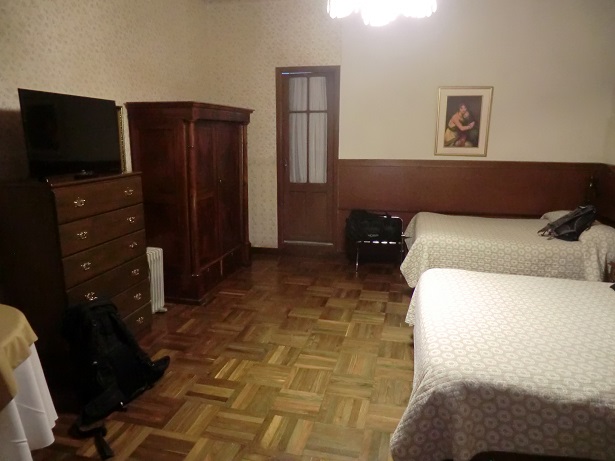
Our new room at Capital Plaza Hotel.
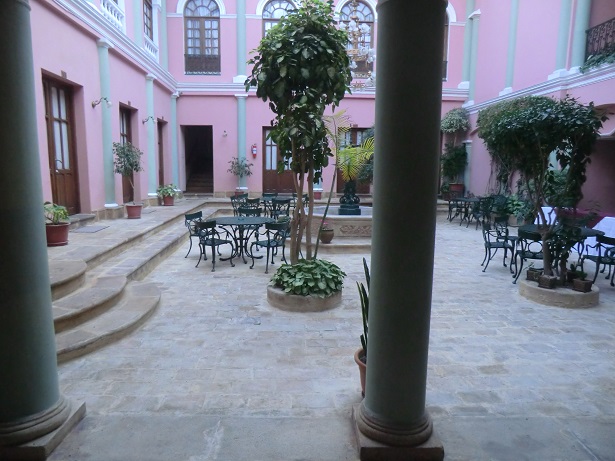
Capital Plaza´s beautiful interior.
18.43 It is lovely with a large room. One setback is the fact that the internet connection is weak here. I guess that we can't have it all. We have rested a while and Christer has started to recover from his health-related dip.
20.02 The time has come for the first dinner here in Sucre. A dog was sleeping outside of the hotel. This evening we will drink mango/cardamom juice as well as a local IPA beer. To this it will be Pad Thai and sweet and sour pork. We are at Chifa & Thai (https://www.soysucre.info/chifa-thai), an Asian restaurant with Latin American influences. They offer Chinese food, Thai food and even vegetarian food. 21.02 We went home just enough filled. It was just a short distance to the hotel located at the city's Central Square, Plaza 25 de Mayo. We had some problems finding the entrance to the hotel. Good thing that the sleeping dog was still there. 22.37 It's nice to be at a lower altitude. Here we are only 2810 meters above sea level. Compared to Potosí, it feels really low. Tomorrow begins the first of several full days here in pleasant Sucre.
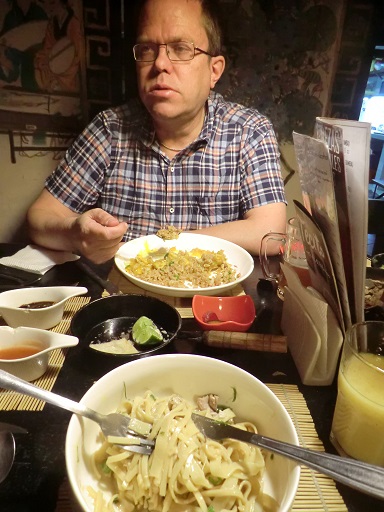
Peter is dining at Chifa & Thai.
You can see 190 photos from July 9 in this photoalbum.
You can see 47 photos from July 10 in this photoalbum.
You can see 20 photos from July 11 in this photoalbum.